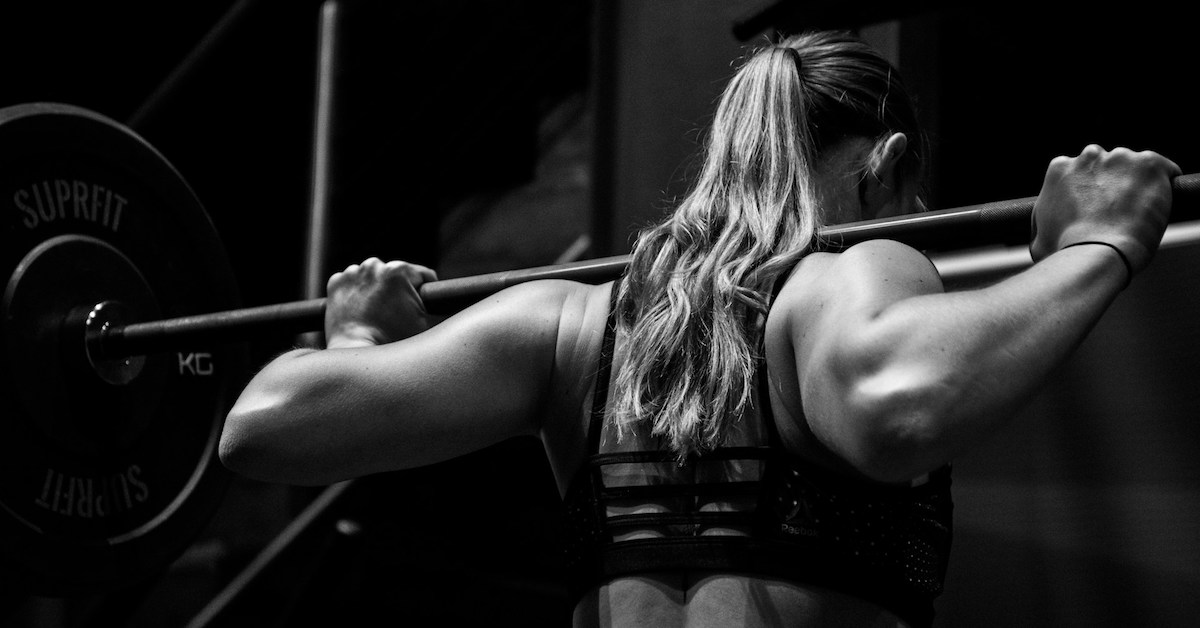Q: All the techniques on your DVD are awesome! If you’re pinched for time, which general warm-up method would you use?
A: Make sure to perform dynamic stretching before every workout. It just takes a few minutes but can make a big difference in your performance.
To recap, when performing dynamic stretches, use the pendulum method: start slow and shallow, and gradually increase speed and range with each repetition.
Dynamic Stretching Routine:
- Squat
- Split Squat
- Toe Touches
- Waiter’s Bow
- Side Bends
- Trunk Twists
- Arms Horizontal
- Arms Vertical
- Arms Vertical Alternating
- PNF Pattern
- Arm Circles
- Wrist Flexion/Extension
- Wrist Circles
- Shoulder Shrugs
- Head Tilt
- Head Rotation
Many coaches prescribe too many repetitions for dynamic stretching. According to Hartmann & Tunnemann in Fitness and Strength Training for All Sports, the repetition stretching method involves:
Stretching with repetitive pulls or bounces using small intervals, rather than just one pull. An athlete begins the first repetition over a relatively small range of joint motion, gradually increasing the amplitude range, reaching after 15-20 movements, the maximal range. The process is then repeated 3-4 times, using body weight or an external force (weight, partner, etc.).
The authors emphasize that stretching methods should be performed after training; however, dynamic stretching before training can help reduce muscle damage and improve performance. It will also rev up the nervous system in preparation for activity.
Keep in mind that it takes only 10-15 seconds of contractions to raise body temperature by 1ºC, and a proper warm-up should increase it by 1-2ºC (1.4-2.8ºF) to induce sweating. Five to ten reps per movement is all you really need.
Remember, the goal of a warm-up is performance, not fatigue!
Q: I’m interested to know your thoughts on overshooting the training load in a warm-up for a set of 3×3.
For example, if I were to do 3×3 in the bench press at 335 lbs, my normal warm-up would be:
45×10
135×8
185×5
225×4
275×3
315×2
365×1
Then I would do 3×3 at 335. I’ve done this before, and the heavier single before my work sets seems to “wake up” my nervous system. This is only anecdotal, but I’d love to hear your thoughts.
A: Yes, this is a very effective method utilizing postactivation potentiation (also known as post-tetanic facilitation). However, your jump from 315 to 365 is rather large—I would insert 1 or 2 more singles here.
Keep in mind that as you ramp up the weight, the difference in load between successive sets should actually decrease. Looking at your scheme:
- 225 to 275 = 50 lbs
- 275 to 315 = 40 lbs
- 315 to 365 = 50 lbs (too large)
Instead, insert either one more warm-up set at 345 for a single (a 30 lb. jump) or ideally two more warm-up sets at 335 and 355 for singles. Then go ahead with your work sets at 335—you should notice an increase in strength.
Q: At one of your workshops, I remember you mentioning that plyometrics are good during a warm-up. What are some options for the upper body?
A: Yes, plyometrics can be very useful during a warm-up—but don’t go overboard! They place a tremendous amount of stress on the nervous system. Too much will kill performance, but just the right amount can enhance strength.
For upper-body plyometrics, check out the Explosive Upper Body Warm-Up Video from my Warm-Up to Strength Training DVD. For lower-body plyometrics, I recommend Christian Thibaudeau’s Modern Strength Newsletter series, which you can still access at www.angelfire.com/ct3/modern-strength.
The DVD also covers the three-stance vertical jump test from Chad Waterbury, which will boost your squat in no time.
Q: In a recent article, you stated that some strength athletes gauge their recovery using an unloaded bar—or even a broomstick—during their warm-up. Surely you’re kidding?
A: Not at all. Something I learned from Poliquin and Kinakin is that Mike MacDonald would start his warm-up by benching a broomstick. If it felt off, he wouldn’t train that day!
For context, MacDonald set 36 world records in the bench press across four weight classes and held those records for five years straight (1976–1981)—all raw lifts without a bench press shirt or elbow wraps. Success leaves clues…
Also, a broomstick can be used diagnostically. Try an overhead squat with a broomstick before loading the movement. Check for:
- Forward lean
- Heel rise
- Knee position
- Foot rotation
- Squat depth
- Spinal curves
- Arm and head position
Address any issues with targeted stretches (refer to my Stretch for Strength online video for more details).
Q: I have a client with a classic kypholordotic posture and past lower back issues. How should I warm him up?
A: To address kyphosis (hunchback posture), have your client lay on a foam roll lengthwise along the spine, building up to 15-20 minutes daily. When done before training, this simple maneuver can increase strength by up to 3%.
Then perform this sequence:
- Camel/Cat: 5-6 cycles
- Dog Maneuver (Fire Hydrant): 5-10 reps
- Birddog (Dynamic Horse Stance): 5-10 reps
- Ab Vacuum: 10-12 reps (5-10 sec. contractions)
- Pelvic Tilt: 10-12 reps (5-10 sec. contractions)
- PNF Stretches: 2-5 sets (6-8 sec. contractions)
- Swiss Ball Stretches: 15 sec. static, 6-8 sec. PNF, 5-10 reps dynamic
- Dynamic Stretches: 5-10 reps per movement
Also, perform passive PNF stretches for the following areas:
- Calves
- Hips (piriformis, glutes, TFL)
- Hamstrings
- Hip flexors
- Knee extensors
For a deeper stretch, have him lay over a Swiss ball and gradually move into a pec stretch. Follow up with PNF pec stretches in three positions and shoulder PNF stretches.
Caution: If he experiences low back pain, avoid toe touches, side bends, and twists initially. Keep a neutral spine with braced abdominals throughout training.
Q: Great DVD! Any more warm-up tricks to increase strength?
A: An effective warm-up method involves post-tetanic potentiation. By gradually ramping up your low-rep warm-up sets beyond your working weight, you can increase strength for your work sets. There are several ways to tap into those high-threshold fibers, such as performing eccentrics or heavy supports with loads greater than your working weight. Another trick is adding chains to the bar—this naturally slows down the concentric speed (although your intent should always be fast). Then, remove the chains for your work sets, and you’ll go through the roof!
A simple piece of advice I picked up from Ironman’s Editor-in-Chief Steve Holman is to lock out (i.e., full ROM) on each repetition of your warm-up sets. This helps lubricate the joints. I’ve said it before, and I’ll say it again: warm-ups should be about performance, not fatigue. If you don’t lock out and instead keep a slight bend at the top range of motion, you’ll increase tension and promote fatigue—great for hypertrophy training, but not so great for pre-hypertrophy training!
Q: In an article of yours, you mentioned that some studies show no difference in performance with or without a prior warm-up. So why bother warming up?
A: The quick answer comes from Supertraining (pg. 161):
Almost all studies which show warming-up to be detrimental used untrained subjects who apparently cannot tolerate high-intensity warm-ups.
Furthermore:
Athletes in endurance events or low-intensity sports do not benefit much from warming up. (Siff & Verkhoshansky, 1999)
So unless you’re an untrained individual or performing a low-intensity sport, a proper warm-up does matter.
Q: In your Warm-Up to Strength Training DVD, you mention that static stretching may decrease strength. I used to do at least half an hour of static stretches before lifting, then warm up with a light weight on each exercise. What a big mistake! Ever since I switched to your dynamic stretching circuit and specific warm-up suggestions, I’ve actually started making progress. Just curious—anything else that zaps strength?
A: Well, there is something else… but you may not want to hear it. I’ll let the following abstract break the news. You ready? Sit tight—this might be painful:
Alterations in grip strength during male sexual arousal.
Jiao C, Turman B, Weerakoon P, Knight P.
Int J Impot Res. 2005 Oct 27.
School of Biomedical Sciences, University of Sydney, Sydney, NSW, Australia.
Although it is known that alterations in grip strength occur under a number of conditions, little is known about relationships between grip strength and sexual arousal. This relationship was investigated in 30 healthy heterosexual males, who viewed both erotic and non-erotic videos. A questionnaire was used to assess the extent of sexual arousal. The grip strengths of both hands were measured with a five-position (P1-P5) dynamometer, before and after watching the videos. After watching the erotic video, there was a statistically significant reduction in grip strength for the P2 position, with nonsignificant overall reductions in grip strength for all other positions tested. No such effect was observed in control tests. The results indicate that during sexual arousal, the neural system is likely to reduce the output to muscles not directly related to sexual function, presumably to enhance the physiological responses of sexual arousal.
Take-home message: Sexual arousal is great anytime—except right before training!
Q: I have been diagnosed with a SLAP tear in my right shoulder. Haven’t decided whether to go through with surgery yet, but I don’t want to make things worse with my training. The exercises in your Strong and Healthy Shoulders article are really helping. Are there any good stretches I should perform?
A: If you’re dealing with shoulder instability, do yourself a big favor and check out the three-part series The Disabled Shoulder by Burkhart, Morgan, and Kibler in Arthroscopy: The Journal of Arthroscopic and Related Surgery.
One highly effective stretch is the sleeper stretch, which can help with a SICK scapula (Scapular malposition, Inferior medial border prominence, Coracoid pain and malposition, and dysKinesis of scapular movement). Here’s how to do it:
- Sleeper Stretch:
Lie on your side with the involved arm against the floor, perpendicular to your body. The shoulder and elbow should be flexed at 90 degrees. With your other hand, gently push your forearm toward the floor, keeping the elbow fixed as a pivot point. This will effectively stretch a tight posteroinferior capsule. - Roll-Over Sleeper Stretch:
Similar to the sleeper stretch, but here, the shoulder is only flexed 50-60 degrees, and you roll forward 30-40 degrees from a vertical side-lying position.
To stretch the posterior musculature (rather than the capsule), try a cross-arm stretch:
- Cross-Arm Stretch:
Stand with the shoulder flexed at 90 degrees, then passively adduct the arm across your body. This can also be done against a Swiss ball.
Another essential stretch is the doorway stretch, which helps open up the inferior capsule:
- Doorway Stretch:
Place your arm at 90 degrees of abduction with the elbow bent at 90 degrees on the edge of an open doorway. Lean forward slightly to feel the stretch in the anterior shoulder capsule.
These stretches, combined with proper strength training modifications, can help keep your shoulder healthy while you decide on surgery.
Final Thoughts
Warm-ups should enhance your performance, not fatigue you. Avoid long static stretching before lifting, be mindful of neural fatigue from sexual arousal, and use smart prehab strategies if you’re dealing with shoulder instability. With the right approach, you’ll keep progressing safely and effectively.
![Warm-Up to Strength Training [DVD & Online Video]](https://theelitetrainer.com/wp-content/uploads/2019/03/Warm-Up-to-Strength-Training.png)
Warm-Up to Strength Training [DVD & Online Video]
Traditional warm-ups drain strength and increase injury risk. This 35-minute DVD (or online video) reveals unique, research-backed methods to prime your body for peak performance. Endorsed by leading experts and featured in multiple fitness magazines, it’s one of the best training investments you’ll ever make. Includes a printable text insert for easy reference at the gym.

Stretching Smarter: The Do’s and Don’ts for Maximum Flexibility
By JP CatanzaroOriginally published: September 23, 2014 – Updated for 2025 Want to boost flexibility, prevent injuries, and optimize performance?

Training Economy: How Weight Training Can Be Your All-in-One Fitness Solution
Recent research has once again confirmed what many in the weightlifting community already know: weight training isn’t just for building

4 Invaluable Lessons from Strength Training Pioneer Arthur Jones
Arthur Jones, a true visionary in the realm of strength training, left an unforgettable mark on the fitness industry with
follow
Error: No feed with the ID 2 found.
Please go to the Instagram Feed settings page to create a feed.
